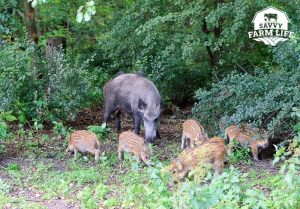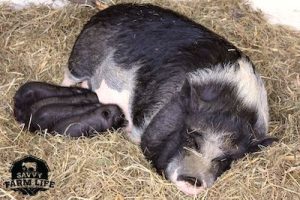What’s The Term for a Female Pig?
Most of us know what a baby pig is called – after all, we have all seen our share of adorable piglet videos and pictures online. But what about the protective mothers of these piglets – what are female pigs called?
What is a female pig called? A female pig who has not been bred is called a gilt. A gilt can be a female pig that is not yet sexually mature, or a female pig raised solely for meat. A female pig who has been bred is called a sow, or less commonly, a cow. Sows are raised for producing offspring, and can have up to two large litters per year.
If you’re looking to raise pigs in the future, you are probably considering starting with female pigs. With any livestock animal, females are usually less aggressive and more easy to handle than an intact male. Either way, you should still do your research about raising female pigs. Keep reading to learn more!
The Social Structure Of Female Pigs
Because of the prevalence of feral pig groups, we are able to see first-hand how a group of pigs is structured if allowed to follow their natural instincts. Natural pig groups typically include a handful of sows and their piglets. When male pigs get older, they are removed from the group and live in solitude or in a group with other boars (male pigs).
Female Pig Hierarchy
 There is a delicate hierarchy within the group of female pigs, with a dominant pig acting as the leader. This hierarchy develops when the pigs have reached sexual maturity, and typically lasts until the group is disrupted by new members. Dominant sows often give birth to dominant piglets – this can be attributed both to genetics, and also to environmental factors (the dominant piglets tend to get the most milk and suckles from the more favorable teats). Interestingly, piglets suckle from the same teat every time they nurse, with the more dominant piglets “winning” the teats that are closest to the sow’s face.
There is a delicate hierarchy within the group of female pigs, with a dominant pig acting as the leader. This hierarchy develops when the pigs have reached sexual maturity, and typically lasts until the group is disrupted by new members. Dominant sows often give birth to dominant piglets – this can be attributed both to genetics, and also to environmental factors (the dominant piglets tend to get the most milk and suckles from the more favorable teats). Interestingly, piglets suckle from the same teat every time they nurse, with the more dominant piglets “winning” the teats that are closest to the sow’s face.
Most groups of pigs have been together from the time they were piglets, which is when this hierarchy is determined. Piglets will initially fight to determine social status, and once this is established, will maintain their positions through threats. Dominant sows will often bark at other sows to remind them that they are in charge.
Female Pigs Will Raise Piglets Communally
Within a herd, sows will often go into heat at the same time, which allows them to raise piglets together. Sows tend to raise their piglets communally, with one keeping watch over the piglets of the group while the other females go out in search of food. In fact, if something should happen to a sow, the others will take the injured or deceased sow’s piglets as their own, nursing them and raising them with their own litter.
When Do Female Pigs Reach Sexual Maturity?
On average, gilts will reach sexual maturity at around 6 months of age. Some breeds will mature as early as 4 months of age, while other breeds may reach sexual maturity closer to one year of age. Gilts between the ages of 14 and 17 weeks are particularly sensitive to stressful situations, and a negative experience can delay the onset of puberty.
While the age at which a gilt reaches maturity will vary, particularly among different breeds, the general consensus is that a female pig should not be bred before 6 months of age. Early breeding can have a negative effect on the sow. Sows that were bred and produced a litter too early are more likely to experience problems in pregnancy, stillbirth, and litter size reduction. Young sows are also more likely to lack the maturity that is required to raise piglets, and may neglect their young. For these reasons, it is recommended that gilts not be bred until at least 6 months of age.
Female Pigs: Farrowing Behavior
In pig terminology, farrowing refers to giving birth. Pigs are usually raised for meat, and so pigs have been bred to produce larger litters and attentive sows. For this reason, most sows make excellent mothers, tending to and protecting their young effectively.
Isolating From The Group
Between 24 and 48 hours prior to farrowing, sows will isolate themselves from the herd in search of a suitable nesting site. Free-range and feral sows will walk long distances to find the right farrowing location – usually seeking a nesting site that is between 1.5 and 4 miles away from the group.
Sows search for sites that are well-hidden so that they can protect their young. Researchers studying free-range sows have noticed that female pigs seem to prefer areas that are on a slope. This may help them feel that they are high enough to have a protective vantage point, and low enough to hide.
When it comes to domesticated pigs, you should provide your sow with a quiet place where they can have their young. This could be a barn or a run-in with soft and clean bedding.
Nest Building
A sow will always build a nest in which to farrow her piglets and raise them for the first 7-10 days. When she has found a suitable site, the sow will root around in the ground until she has created a hole that is 2-4” deep. Once she has this area properly disturbed, she will cover it with soft plant material, then sticks and twigs, and finally with grass and leaves. Sows take the business of nest-building seriously, and one free-range pig in Brazil was found to have used 560 pounds of plant material to build her nest.
The sow will continue to perfect her nest right up until the time that labor approaches. After she has finished building her nest, her first piglet will usually arrive within a couple of hours.
How Many Piglets Do Female Pigs Have?
 Over the years, sows have been bred to produce large litters of piglets, and specific litter sizes will vary according to breed. Most breeds will easily farrow 8-10 piglets at a time, with many popular meat breeds producing 12 to 15 piglets at a time. The breed that consistently farrows the largest litters is the Meishan. Meishans regularly produce litters of 15-20 piglets at once.
Over the years, sows have been bred to produce large litters of piglets, and specific litter sizes will vary according to breed. Most breeds will easily farrow 8-10 piglets at a time, with many popular meat breeds producing 12 to 15 piglets at a time. The breed that consistently farrows the largest litters is the Meishan. Meishans regularly produce litters of 15-20 piglets at once.
With sows going into heat twice per year, this means that a single sow can farrow 20 – 40 piglets per year. This is an incredible rate of reproduction, and is one of the reasons that the feral pig population is currently out of control.
Meishan Pigs are some of the best meat producing pigs out there. To learn about the best meat producing pig breeds, visit my article Meat Pig Breeds: 8 Best Pig Breeds For Meat.
Female Pigs: Post-Farrowing Behavior
Pigs are usually excellent mothers, and domestic pigs do not require much in the way of human intervention when it comes to raising their young.
The Piglet’s First Week of Life
When a sow is ready to farrow, she will lie down on her side and will stay in this position for the duration of the labor. In fact, for the first 48 hours post-farrow, she will spend 90 – 95% of her time in this position. Some theorize that the sow remains so passive during the first couple of days post-birth because it decreases the chances that she will accidentally crush one of her piglets. This theory makes sense, as a 600-pound sow in a nest with 15 piglets can be a dangerous combination.
After farrowing, sows will keep their piglets in this isolated nest for another 7-10 days, during which time the piglets develop a hierarchy and familiarization with one another. Around day 7, the sow will leave the nest to search for food with the rest of her group. A couple of days later, she will bring her piglets with her for a short time. A couple of days after that, she and her piglets will move back into the group permanently.
Nursing Behavior
Sows exclusively nurse their young for the first 4 weeks, after which time they will begin eating solid food. After the first 4 weeks, nursing will gradually decrease until the piglets are entirely weaned between 8 and 19 weeks. Some of this decrease will be piglet-led, with the young taking more interest in rooting and eating solid food. Some of this decrease will be sow-led, with the female pig cutting off the nursing sessions early by getting up and walking away.
When a sow is nursing her young, she will often “sing” to them – grunting rhythmically while the piglets settle in. This grunting will start out soft and will increase in volume while the piglets are nursing. By the time her song reaches a higher volume, her piglets will be mostly quiet and calmly nursing. This “song” will start and stop over the course of the nursing session. Because a lot of bickering can break out amongst the piglets while nursing, it is possible this rhythmic grunting is used to calm the pigs down.
Female Pig Behavior
Pigs are fascinating animals, and it is fun and interesting to learn about the behavior of sows and how they raise their young. Because there is such a large population of both feral and wild pigs, we are able to learn the specifics of pig behavior and how our domesticated farm pigs would act if allowed to follow their natural instincts. This knowledge can help us raise our domestic pigs in a way that is fulfilling for both them and for us.
Raising any animal comes with a financial commitment, and pigs are no different. To get a complete rundown of the expenses to expect when raising pigs, visit my article How Much It Costs To Raise Pigs: Complete Expense Guide.
